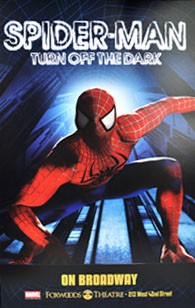[The Wicked Stage made a whirlwind tour of NYC over the weekend. Some ruminations below.]
I'd normally say "better late than never," but in the case of Spider-man: Turn off the Dark, I'm not so sure. Originally, I had tickets for a January performance (i.e. during the ill-fated, perilous run of Spider-Man 1.0), but the Great Blizzard of 2011 put the kibosh on that. And yet I sense that January's version--still entirely the work of visionary madwoman Julie Taymor--might not have been simply awful, but exhilaratingly awful. Alas, 2.0 is kind of bland, more of a theme park show than a real musical, with an occasional splash of Saturday morning cartoons. The score and lyrics by Bono and the Edge are completely forgettable, and the production's mishmash of styles and sensibilities reflects this version’s mishmash of book-writers and directors. But let me sing the praises of George Tsypin’s brilliant set design, which precisely captures the kooky angles and neo-noir look of the best of narrative art: Tsypin’s a whiz at using the stage like a gigantic comic book page, pulling off visual coups you wouldn't think possible. (The concluding bird’s-eye duel on the Chrysler building is simply stunning.) The kids next to me were visibly squirming during the ballads, but perked up considerably during the flying sequences—and when Spider-man landed on our balcony and gave one lucky kiddo a high-five, the lad just about soiled himself. (I suppose that registers as praise, however faint. We thus award Spider-Man two feces out of five.)
Meanwhile, some real plays were on the boards in Manhattan, including Tyne Daly's fascinating turn as Maria Callas in Terrence "Corpus Christi" McNally's Master Class. To be frank, Daly isn't an obvious choice to play a svelte, sophisticated European diva: tough, working-class dames have been her forte. But yes, she pulls it off: regal, imperious, vulnerable, and very, very witty. The play itself has a solid structure—Callas terrorizes three operatic wannabes during a Juilliard master class on singing—while McNally investigates the intertwined artistic and personal lives of La Divina. Both the play and the production go off the rails during two long monologues, however: director Stephen Wadsworth clears the stage, but also kills the dramatic momentum, leaving Daly looking lost in the dark. Still, a solid evening that proves that Daly can conquer practically anything.
After mixed reviews in the spring, I was somewhat surprised that the musical Catch Me If You Can was still playing in NYC, though a Tony win for lead actor Norbert Leo Butz certainly helped. Generally mounted by the same crew that brought Hairspray to the stage, CMIYC is entirely professional and pleasant. It features an interesting story—of a young con artist's incredible escapades over a run of about two years—and solid performances, including some diverting production numbers. And yet
and yet
I found aspects of the production too forced to be affecting—a sub-plot involving a no-goodnik Dad smacked of dime-store psychology—and nothing in the score ever soared, not even during Butz's hard-working performance. I wonder if there will be enough enthusiasm to put together a national tour.
On Sunday, I caught the final performance of Stephen Adley Guirgis's The Motherfucker with a Hat, a title that the Gray Lady refuses to print, and which I would put in <blink> if I could get the HTML to work. Motherfucker is the Platonic form of an off-B'way play—five characters, one act, interior sets—and which only wound up on Broadway because of the casting of Chris Rock (as a smooth-talking self-help guru). Unfortunately, Rock is the weak link in a top-notch ensemble that includes Bobby Cannavale (who's electrifying) and Yul Vázquez (superb), with a zippy, profanity-fueled script and high-energy performances. The plot isn't particularly novel—two couples intersect in various constellations of desire and detestation—but Guirgis's raw, streetwise language is infectious. I predict this will be a hit on the regional circuit.
Lastly, I caught director-of-the-moment Rupert Goold's Romeo and Juliet during the Royal Shakespeare Company's stint at Lincoln Center, for which the RSC built its own Globe theater (!) inside of an armory. (Which is insane. But I'm glad they did it anyway.) Goold's R&J epitomizes postmodern approaches to Shakespeare: the director threw everything at the text (bicycles, iPods, fire extinguishers) in the hopes that some of it would stick. Some of it did, though the framing device (of a museum audio-tour) made no sense and could have been profitably dropped from the three-and-a-quarter-hour production. (I have no idea if there were any edits, but given the running time, I think very few.) I caught an understudy Romeo—the first-stringer was injured during an earlier matinee—but Dyfan Dwyfor was in fine form; nobody could compare to Jonjo O'Neill’s mercurial Mercutio, however. A footnote: after the final bow, a patron behind me struggled to wipe away her tears ("I had forgotten the ending was so sad," she embarrassedly explained to her friend). No need for shame: the day we can't shed a tear for such star-cross’d lovers is the day this critic hangs up his (motherfucking) hat.
--Thomas "La Divina" Jenkins, Current theater critic.


